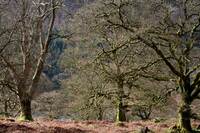Forest landscape plans [Fig 8.20] should be set forth in public documents, with simplified versions displayed in visitor centres and similar places. This would make the public aware of the forest industry's respect for the landscape. The plans should explain how the design has been related to existing features; how the design concept for the forest was generated; visual quality objectives; areas of broadleaf retention and planting; silvicultural systems; conservation areas; areas which will become old growth woodland; habitat creation areas; wildlife networks; recreational networks; art trails; story trails; provision for hunter-gathering; historic trails; the provision of footpaths, bridleways, cycle paths and other recreation facilities; integration with agriculture and other nearby land uses. Even if the Commission continues to be exempt from planning control, the landscape plan, and its accompanying report, should be made available to local authorities and deposited in local libraries. This is normal practice for large quarries, reservoirs, power stations and other major projects, where the industrialists must demonstrate their good neighbourliness [Fig 8.21].
The principal objective of the Forestry Commission is 'the efficient production of wood for industry' (Forestry Commission 1984) but this cannot be the principal objective in every part of every forest. Some 'forests' should be managed as woods, others as wilderness. In many places the duty 'to protect and enhance the environment' or 'to provide recreational facilities' will take precedence over the principal objective. Decisions about priorities will be based on an environmental assessment of forest location and site characteristics. Nature reserves are already mapped and protected. The Nature Conservancy has asked for conservation to be included in the written plan of operations which is prepared for every forest (Kirby 1984). Similar attention should be given to areas of high scenic and recreation value.
There is a great need for foresters to consider the wider context and to become expert in EID. They can help to create a national web of greenspace open to the public. Wherever possible lake shores, ridge lines, viewpoints, streams, recreational facilities, long distance footpaths and scenic areas should be incorporated. Forestry has an important role in and around urban areas. In rural areas the web land should be subject to retention policies so that it stands between zones of 'maximum modification' in the same way that hedgerows and farm woodlands make compartments in the agricultural landscape.
Forests require special legal and planning regimes. Those who frame them should study forest history and learn from the successes and failures of the industrialised countries. A 'forest' should not be merely a large wood: it should be a place where special laws apply. Originally, the laws were framed to benefit kings and nobles. In Britain, the 1919 law was framed to provide a national strategic reserve of timber: it was almost an act of war. Today, forest laws should be aimed at the creation of public goods, including a strategic reserve of timber and wild food.



